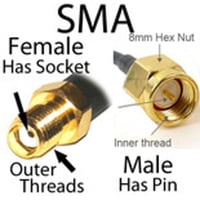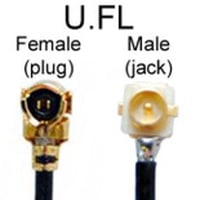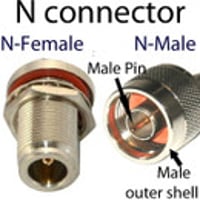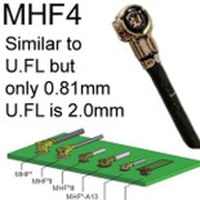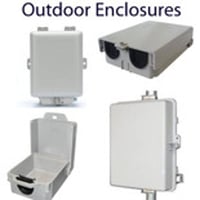5GHz: 4.9~6.0GHz Antennas
5.1 to 6 GHz Frequency Band
The 5GHz frequency band is an unlicensed ISM spectrum commonly used as an alternative to the higher frequency 2.4GHz frequency. This band comprises of 4 RF bands; 5.1, 5.3, 5.4 and 5.8GHz, resulting in 24 non-overlapping channels separated by 20MHz. The channels can potentially be used on a single wireless system without the risk of interference. The WiFi standard 802.11ac operates in the 5GHz band, and therefore has less interference than the previous standards 802.11n, etc.
- See Legal and Illegal channels within the 5.1-5.8 Frequency Band.
- Summary comparison of 5.1-5.8 GHz, 2.4 GHz and 900 MHz bands.
The 5GHz band offers shorter range coverage but at higher data rate than 2.4GHz (2400MHz) frequency band. It has less penetrating power through physical objects like walls compared to 2.4GHz.
5.1 to 5.8GHz frequency bands are used in fast data rates applications. And where the more popular 2.4GHz frequency applications cause severe interference, an alternative frequency is needed for low noise transmission. 5GHz frequencies are commonly used in WiFi and W-Lan applications that use a dual frequency router that is able to switch between 5GHz and 2.4GHz networks.
Common applications of 5GHz frequency band include:
- 5.8GHz ISM applications
- Network access points
- Radio local area networks
- WiFi and Wireless LAN applications
- WiMAX networks
- Wireless audio and video systems.
Local regulations and restrictions on the use of this frequency may change depending on the region or country.
Omnidirectional Antennas for the 5.8 GHz Frequency Band
'Omni' means 'all' and an omnidirectional antenna simply sends and receives radio frequency energy in all directions surrounding an upright antenna. It is a distinct class of antenna from directional antennas that focus radio frequency signals in a specific direction.
The radiation field emitted by an antenna can be presented visually in a radiation pattern and an omnidirectional antenna pattern will show that these antennas radiate maximally in the 360-degree horizontal plane, producing a circular field around the central antenna.
The radio power transmitted by an omnidirectional antenna will decrease towards the extremes of the antenna's vertical axis, producing a characteristic 'doughnut' shape when the radiation field is viewed in 3D.
Why an Omnidirectional Antenna is Important:
The right antenna is essential to the proper functioning of any radio frequency setup, so you need to choose the omnidirectional antenna that will deliver the physical and electromagnetic properties your project requires.
Omnidirectional antennas are the first choice for creating all-round coverage and the correct use of an omni antenna will improve the distance, strength, and penetration of your transmitted signal.
Your choice of omnidirectional antenna will be critical for the optimal performance of your product or network. Careful evaluation of the characteristics and properties of omni directional antennas, as described below, will assist in meeting the necessary physical, mechanical and environmental requirements for successful deployment.
Key Omni Antenna Features and Characteristics:
- This class of antenna is advantageous as the majority of its energy is transmitted horizontally in all directions, rather than up to the sky or into the earth where it would be wasted.
- An omni antenna has a distinctive 360-degree antenna pattern which is circular across the horizontal axis and doughnut-shaped in 3D.
- Narrowing an omnidirectional antenna's beamwidth, the area from which most of the antenna's power is emitted, can increase the horizontal coverage and communication distances that can be achieved, though coverage below the antenna will become limited.
- Omnidirectional antenna polarization is usually linear vertical, though it is possible to have circularly polarized omni antennas too.
Omnidirectional antenna advantages and disadvantages
Omnidirectional antennas have a number of notable pros and cons.
- Their 360-degree field makes them easy to install and they can even be mounted inverted from ceilings.
- In the event of a network change, you are less likely to have to reposition or adjust these antennas because they transmit and receive signals in all directions.
- Their radiation pattern also makes them favorable for indoor use or for fixing to mobile devices like walkie talkies.
- As mentioned above, with an omni directional antenna long range can be achieved by narrowing the beam width, and gaps underneath can be remedied by using a downtilt to provide greater coverage beneath the antenna than above.
There are also a number of weaknesses in the omni directional antenna design that will limit the use and performance of these antennas unless they are overcome.
- Due to the bulbous shape of the omnidirectional antenna pattern, there is often poor coverage below the antenna. This can be especially pronounced if the antenna is mounted at height.
- Omni antennas can be susceptible to interference as they receive signals in all directions.
- The gain of these antennas is usually lower than comparable directional antennas.
- It may be difficult to achieve cross-polarization with these antennas.
Omnidirectional Antenna vs Directional Antenna:
This quick table summarizes the major differences between a directional antenna vs omnidirectional units.
| Directional Antenna | Omni-Directional Antenna |
|
|
Omni Directional Antenna Types
These antennas are classified in a variety of ways, giving rise to a broad range of examples of omnidirectional antennas from which you can choose.
- Dipole antennas are simple and widely used. They are one of the original antenna designs, created by Heinrich Rudolph Hertz, the first person to prove the existence of electromagnetic waves! They are made by the end-to-end orientation of two conductors with the feedline at the midpoint.
- Monopole omnidirectional antennas or ground plane antennas are essentially half of a dipole antenna and consist of a straight rod mounted perpendicularly to a conductive ground plane.
- Whip antennas are made from a flexible wire or rod and are a type of monopole antenna. They have an omnidirectional radiation pattern.
- Rubber Ducky antenna. The Rubber Duck aerial is another monopole variant and consists of a spring-like helical wire sealed in rubber or plastic. It is relatively weak and so best designed for indoor use where only small coverage is needed. They are often attached to domestic WiFi routers.
- Discone antennas are omni-directional and vertically polarized. They consist of a vertically mounted disk with a cone beneath.
- Halo antennas are omnidirectional dipole antennas that have been curved to form a horizontal loop with a gap over the feed point. They are horizontally polarized.
- Horizontal Loop antenna these horizontally mounted antennas are an older but highly effective omni-directional antenna design square, rectangular, triangular, or delta in shape.
- Spider antennas are an efficient type of omnidirectional outdoor weatherproof antenna made from fiberglass and wire and can even be used for portable use as it is lightweight.
- Omnidirectional blade antennas are predominantly used in aviation due to their aerodynamic design. They are planar monopole antennas with wide bandwidth.
Applications of Omnidirectional Antennas
Subject to proper planning, assessment, or site survey for your radio frequency set up, omnidirectional antennas perform well in a range of applications. The distinctive characteristics of these antennas make them indispensable in wireless systems when correctly deployed. Uses for omni antennas can be broadly divided into outdoor and indoor applications.
Outdoor
With the best omni directional antenna outdoor use is advantageous as their all-round coverage enables the roaming necessary to find a signal and they are usually compatible with a range of base stations and access points.
This makes the omnidirectional WiFi antenna outdoor, particularly sought after for public WiFi access in hospitality and recreation settings. They will often feature as part of point to multi-point WiFi solutions, for example in parks or to cover a large property like a farm or ranch. An omni directional antenna for caravan owners or omni directional marine antenna facilitates the bringing in of signal in a remote location and also harnesses the mobility benefits of this antenna class. With appropriate mounting, omni antennas can be used with walkie talkies, on vehicles, and omni-directional WiFi antennas are often installed within mobile devices.
These outdoor antennas also can be adapted for long-distance coverage using the 'pancake effect', where beamwidth is narrowed down. A clear line of sight is essential for accomplishing this.
Indoor
These antennas are usually the first choice for indoor RF propagation and can be discreetly mounted on ceilings or walls. 2.4 GHz omnidirectional antenna coverage can be affected by solid obstructions or interference, but WiFi antennas usually have enough signal penetration for walls and therefore are used successfully to extend WiFi access within buildings as we explore below. When mounting an omni antenna indoors, mount it in the center of the ceiling upside down. Alternatively, mounting a through-hole omni-directional antenna has the benefit of a properly mounted antenna that is not cumbered by wires. Placing an omnidirectional antenna in attic spaces will also assist in achieving coverage throughout a property.
Omnidirectional 2.4 GHz WiFi Antennas
Omni directional antennas are a key class of antenna for wireless communication at 2.4GHz.
What is the 2.4 GHz frequency? The 2.4 GHz frequency is highly utilized for wireless communications because it is a license-free band. This means that unlike those of cellular networks, this frequency is free to use! The ISM bands, of which 2.4 GHz is a key frequency, are parts of the radio frequency spectrum that were designated for Industrial, Scientific and Medical purposes.
Why is the 2.4 GHz frequency important?
The 2.4 GHz frequency has now been widely appropriated for wireless communication. The advantages of wireless networking at 2.4GHz include good range and penetration compared to higher frequencies without significant loss in the speed and performance of connections. The WiFi Alliance adoption of this frequency for WiFi as outlined in the specifications of 802.11b/g/n has led to soaring use. However, heavy traffic has made the 2.4 GHz frequency prone to interference from items as seemingly innocuous as cordless phones, baby monitors, and microwave ovens.
An omnidirectional WiFi antenna is a key part of setting up an outdoor or indoor WiFi network with good all-round coverage at the 2.4 GHz frequency once connected with impedance matched coaxial cable to a router or access point. These WiFi antennas may be single, dual, or multi-band antennas. A dual-band omni directional antenna for WiFi is able to operate using both the 2.4 GHz and 5GHz frequency bands.
Considerations for using an Omnidirectional WiFi Antenna Indoors.
The indoor environment can drastically affect wireless propagation due to the multiple materials and surfaces that make it up. These obstructions will not only absorb radio frequency signals but also reflect, refract and diffract it, adding to the generation of multiple paths in addition to the primary signal originally transmitted.
This multipath effect can cause degradation of the primary signal as the multipath is usually delayed and received after the direct primary signal. This is known as delay spread and increases according to the types of material present. Wood has less wireless propagation loss than materials like concrete. Metal flooring and ducts are reflective and generate more multipath, meaning industrial environments are likely to be more affected by this problem than domestic ones. The overall experience for the user will be a reduced data rate and poorer performance.
The effect of this kind of wireless interference is less prominent in the near line of sight settings where the access points are visible to the antenna and direct communication can overcome any multipath echo present. In the absence of line of sight, direct signals are far less distinct and interference may be greater.
Problems with WiFi interference are not only remedied by increasing the power of the antenna but by analyzing signal quality, positioning of the antenna, and the spatial arrangement of the indoor environment. Building materials and fabrication can also restrict the penetration of WiFi signals through walls or floors.
Frequently Asked Questions for 2.4 GHz Omnidirectional Antennas
How do I increase the gain of an omni-directional antenna?
Unlike directional antennas that can focus RF energy in a specific direction, omnidirectional antennas will distribute any increase in power in all directions. For an omni antenna to achieve a notable difference in signal strength, supplying additional power or narrowing the beamwidth will produce the most significant increases in gain. If increasing the power supply to a 2.4 GHz omni-directional antenna, safe and legal operation is essential. In the US the FCC stipulates that the maximum power fed into an ISM antenna should not exceed 1 Watt.
The limit on Effective Isotropic Radiated Power (EIRP) is set at 36 dBm or 4 watts. At 2.4 GHz, gain can be increased above this EIRP limit, but this must be partnered by a decrease in input power of 1dBm for every 3dBm increase in antenna gain.
How do I mount an outdoor omni-directional WiFi antenna?
- 2.4 GHz omni-directional antennas are usually mounted in a vertical orientation, ideally pointing up, in accordance with the specific manufacturer instructions for the purchased antenna. These are ideally placed in the middle and slightly above the desired coverage zone. The antenna cable should always be connected from below.
- Mount your antenna high and free from solid structures made from concrete or steel that can cause reflections that reduce the antenna's performance.
- Antennas are best placed in the line of sight without obstructions that can block the path of the radio frequency signal. This is best done by ensuring that any client antennas are directly visible.
- The antenna should not be mounted in proximity to high voltage power sources such as power lines, which can cause interference from electrical noise or lethal arcing.
- To prevent signal losses from the antenna coax cable its length should be kept as short as possible. The base station or radio module may need to be brought closer to the antenna to achieve this.
- Outside antenna connections should be completely covered with a suitable weatherproof tape.
- The stability of your outdoor omni antenna mounting is critical as adverse weather can cause a misalignment in the antenna if it is poorly secured. Even a small displacement in the positioning of your omni antenna can cause a partial loss of signal. Ensure all screw elements of your mounting are fully tightened.
- As stated in the National Electrical Code (NEC), guidance, proper grounding of an omni-directional outdoor antenna is necessary for its safe operation and can even improve performance. Grounding prevents dangerous electrical discharge from the antenna in the event of a lightning strike, static, or contact with live wires. There are a variety of ways in which this can be done but most commonly a ground cable is procured and attached.
How do I connect an external omni-directional WiFi antenna to my router?
External omnidirectional antennas can increase WiFI signal quality coverage and speed making it a desirable fix for improving WiFi in your home or business.
As WiFi can operate at either the 2.4 GHz or 5 GHz frequencies, it is worth sourcing a dual-band omnidirectional antenna that will perform at both frequencies.
Routers that have detachable antennas often connect them using SMA or TNC connectors, so your external antenna will need a complementary connector or adapter.
Simply unscrew the existing router antenna and screw in your replacement. An outdoor omni WiFi antenna can be connected in a similar way using a suitably matched coaxial cable with an appropriate connector. If connecting via a cable, the line between antenna and router should be kept as short as possible to keep signal losses along the line to a minimum.
How do I undertake a site survey?
A site survey is an essential part of deploying a WiFi network and will assist in achieving the coverage that you need. Omitting this step is a common cause of the sub-optimal performance of a wireless network.
A site survey may be:
- Passive: where the survey performed is 'listen-only' and not associated with a wireless access point.
- Active: with access points in use and monitoring of data transfer rates.
- Predictive: remotely undertaken software-based modeling based on existing information about the proposed coverage area.
You will need to consider:
- How the proposed WiFi network will be used (e.g. for VoIP)
- The type of setting (industry, commercial, hospitality, or residential).
- If the location is within a building, the number of floors and the materials used in its fabrication (concrete, metal girders, wood, etc). Blueprints or maps should be used to plan the survey and note where coverage is practically needed.
A thorough walk-through of the proposed location for the wireless network is necessary for visual inspection for potential obstructions and identification of potential antenna mounting and access points. Make a note of any existing network infrastructure.
Identify the required coverage area and the access points needed. These can then be verified using a laptop with proprietary software that provides data rates and signal strength and quality at the access point and as you move further away.
All findings should be documented, with the provisional access point locations on a copy of the building or property plans. This should only be completed once you are assured of adequate signal coverage.
Rounding up
The omni-directional antenna is readily reached for as an easy to set up solution for indoor and outdoor wireless networking. Using the 2.4 GHz ISM band has enabled omni antennas to be used in a range of WiFi applications that span the breadth of domestic, commercial, and industrial activity.
As with much radio traffic at 2.4 GHz, omnidirectional WiFi antennas can be subject to interference that causes transmission that is less than expected. Problems are often prevented by a diligent site survey to tackle obstructions, optimal antenna design, and power, and find the siting that will get the best performance out of this versatile antenna class.
LEARN MORE:
- 2.4 GHz | WiFi | Bluetooth Antennas
- Dual band 2.4Ghz | 5GHz antennas
- Antenna mounting gear
- Antenna cables and adapters



